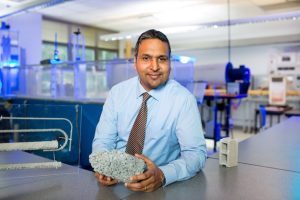
UVic professor and engineer Rishi Gupta. Credit: Armando Tura
VICTORIA – Rishi Gupta, engineer and professor in UVic’s Civil Engineering department, thinks he may be able to combat carbon emissions.
Gupta and his team in UVic’s Facility for Innovative Materials and Infrastructure Monitoring (FIMIM) are pushing the boundaries of what can be done with concrete by replacing cement with other sustainable binding materials, providing an alternative to carbon dioxide sequestration.
According to Gupta, eight per cent of the world’s carbon dioxide (CO2) emissions comes from cement, a key ingredient in concrete, the most commonly used construction material.
One possibility is to use precast products like alkali-activated concrete paver blocks for pavements and parking lots, including those for remote and rural communities. This is done through Gupta’s work with India-Canada Impacts Centres of Excellence (IC-IMPACTS), of which UVic is an affiliate partner. IC-IMPACTS develops, tests and scales up local solutions for India and Canada.
The infrastructure theme of IC-IMPACTS led to Gupta’s first project on geopolymer concrete. Instead of ending up in a landfill, fly ash gets collected from coal-powered plants and then alkali activators are added to make it harden like concrete, producing geopolymer concrete that can be used for applications such as paver blocks. “Geopolymer concrete is technically cementless, as it doesn’t contain Portland cement, which is attributed to global greenhouse gas emissions,” he adds.
Although geopolymer concrete was already in use when Gupta and his team started their research nearly 10 years ago, they took things further by also incorporating the ash that sits at the bottom of coal-burning thermal power plants—a by-product that would also sit in a landfill. “We wanted to take the difficult and less-travelled route of dealing with the bottom ash—in addition to fly ash—as another sustainable option,” says Gupta.
Then there’s the issue of heat. “Geopolymer concrete needs heat during the initial curing period to make it stronger. But heat means energy and producing energy can be a sustainability issue due to associated greenhouse gas emissions,” he explains. Using local bottom and fly ash from both countries, the international research team demonstrated a sustainable technology using 50 per cent fly ash and 50 per cent bottom ash and cured the concrete at ambient temperature conditions.
From there they produced paver blocks. “What we are doing is using sustainable technology and demonstrating its application in the real world. The fact that our geopolymer mixes require little-to-no heating of concrete during production is the greenest part of our research,” says Gupta.
Not only is Gupta’s cementless concrete better for the environment, it has also helped to strengthen UVic’s global connections, leading to a stream of UVic-bound international students excited to be making a difference with climate action research. “It started with a student coming here for an internship, then moving on to complete graduate studies,” adds Gupta. “We’ve had at least six to eight grad students coming to UVic solely from one university in India. Some students were still studying at Nirma University and came here to do the research, and some eventually came back here to do their PhD.” Gupta’s research group also sees students from various parts of the world, including Iran and China.
Gupta and his team are also examining the long-term effects of CO2 sequestering, looking closely at durability—including corrosion resistance—as well as integrating special types of green fibers in CO2-sequestered concrete to make it crack-free and self-healing. This will ultimately result in full service life of structures, reducing the overall lifetime carbon footprint.
Business Examiner Staff & @uvic.ca


